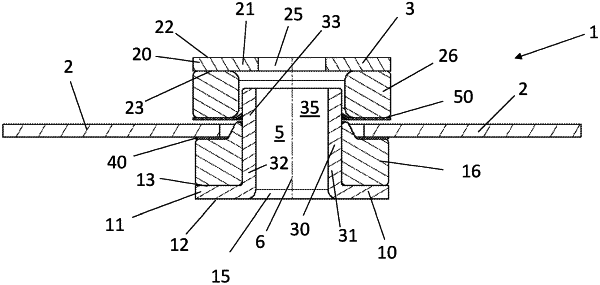| CPC F16B 5/0241 (2013.01) [F16B 5/0258 (2013.01)] | 18 Claims |

|
1. A decoupling element for fastening a heat shield:
the heat shield comprising a passage opening for a fastener and has an axial passage direction; and
the decoupling element comprising:
a middle part containing a sleeve with a first and a second axial end portion,
a lower part arranged adjacent to the first axial end portion of the sleeve, with a first pressure absorption element which, along the axial direction, has a first side for resting against a component or a part of a fastening element, and a second side located opposite the first side,
a first damping element arranged on the second side of the first pressure absorption element,
an upper part arranged adjacent to the second axial end portion of the sleeve, with a second pressure absorption element which, along the axial direction, has a first side for resting against a component or a part of a fastening element, and a second side located opposite the first side, and
a second damping element arranged on the second side of the second pressure absorption element, and a locking disc which is arranged on the second side of the second pressure absorption element; and
the fastener passing through the lower part, the middle part, the upper part, the first damping element, and the second damping element;
wherein at least in one portion of the sleeve along the axial direction, the external diameter of a cross-section of the sleeve perpendicularly to the axial direction, at least along the outer edge of the passage opening, is larger, completely or in portions, than the internal width of the passage opening in the locking disc, and the locking disc has protrusions which extend radially inward toward the sleeve and are bent away from a plane of the locking disc.
|